Introduction
Cognac has been associated with tradition, luxury and refinement over the centuries and is known to have been the favourite aperitif in the days of Nelson’s navy. The region that produces this drink of great style is known as the Charentes and although it is quite small, the many different qualities and styles that are produced vary considerably in aroma and taste. There are thousands of producers making the water clear eau de vie, the distilled wine, ready for its long ageing in oak casks, but many sell it to big brands who blend it, store it and sell it under their own names.
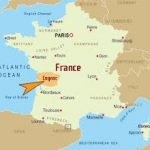 The word ‘cognac’ comes from the town of Cognac which is situated in the very centre of the Charentes region on the west coast of France, about two hours’ drive north of Bordeaux. We refer to cognac as a brandy but that is not to say that every brandy is a cognac, it is not. Cognac is a type of brandy as are calvados, armagnac, marc, grappa and many different grape brandies, which are widely available.
The word ‘cognac’ comes from the town of Cognac which is situated in the very centre of the Charentes region on the west coast of France, about two hours’ drive north of Bordeaux. We refer to cognac as a brandy but that is not to say that every brandy is a cognac, it is not. Cognac is a type of brandy as are calvados, armagnac, marc, grappa and many different grape brandies, which are widely available.
Read more about the Definition of Cognac.
History of Cognac
Cognacs are of course made from a wine, usually produced from a single grape variety known as the St Emillion des Charentes or Ugni Blanc. It is this distilled, or reduced, wine that was responsible for the introduction of cognac in the Charentes region.
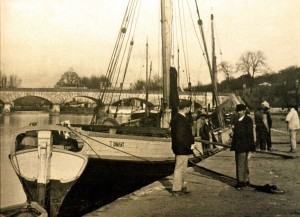 For many centuries wines were shipped along the natural waterway of the River Charente from the vineyards in the Cognac region to the port of La Rochelle. The journey took a long time and in some cases the wine would have become rancid by the time it reached the port. Rather than waste the wine, the locals distilled or reduced it by boiling and then stored it in oak barrels. The story goes that a certain Chevalier de la Croix Maron took two barrels of this to the local monastery and gave it to the monks. On opening the first barrel they found the liquid to be fiery and tasteless. The second barrel was put away and not found until many years later. This time when they opened the barrel it had developed a deep golden colour and it had a wonderful aroma and taste.
For many centuries wines were shipped along the natural waterway of the River Charente from the vineyards in the Cognac region to the port of La Rochelle. The journey took a long time and in some cases the wine would have become rancid by the time it reached the port. Rather than waste the wine, the locals distilled or reduced it by boiling and then stored it in oak barrels. The story goes that a certain Chevalier de la Croix Maron took two barrels of this to the local monastery and gave it to the monks. On opening the first barrel they found the liquid to be fiery and tasteless. The second barrel was put away and not found until many years later. This time when they opened the barrel it had developed a deep golden colour and it had a wonderful aroma and taste.
Over the years popularity for the spirit increased and importers purchased barrels and sold them under their own names. In 1857 however, the law permitted for the first time, trade marks to be registered. Some well-known brands, still around today, were able to impress their own names on their characteristic products.
Read more about the history of cognac at The Cognac Process.
The Cognac Region
Cognacs are made in a region known as the Charentes and Charentes Maritime, on the western coast of France. It is widely accepted that the closer one gets to the centre of this region, the finer the cognac becomes. The town of Cognac is regarded as the centre and lies in Grande Champagne, the best of the six cognac crus.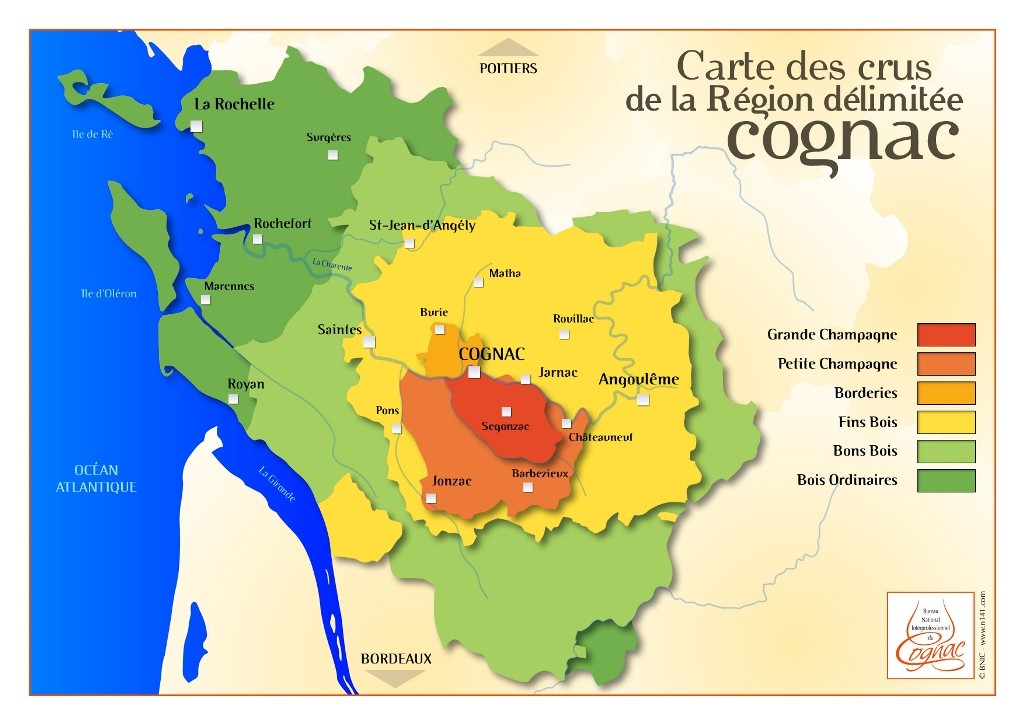
Of the six crus Grande Champagne is the second smallest but produces about 18% of all cognac. Petite Champagne produces about 20%, Borderies 5% and the rest is from the Bois crus.
The main advantage that this region offers to the grape is the soft steady climate and low hills with well drained soil and differing strata levels. The climate is stable with very little frost and a gentle moist air blowing off the Atlantic coast. Temperatures rarely exceed 30 degrees and average around 20 degrees for most of the year.
Many famous cognac names can be found in and around Cognac and the neighbouring town of Jarnac, just 13 kilometres down the road. There are of course many other small towns and villages that can claim a piece of the history and fame of the area. Perhaps the best known are Segonzac, Archiac and Chateauneuf, all in the Champagnes. The simple facades and gates of the small estates in these areas often hide some of the finest producers of the noble spirit.
Read more about The Land and Cognac Crus.
Grapes
Approaching 95% of the grapes in the Charentes are the Saint Emilion du Charentes, better known as the Ugni Blanc. It is a small, relatively acid grape that produces a low alcohol acidic wine, ideal for distillation. The main reason that such a high proportion of Ugni Blanc is used is that the vine crops well and does not produce too high a level of sugar. It is also easy to graft onto the phylloxera resistant root stock which was imported from America. There are other grapes found in the region that are used for making cognac. Folle Blanche and Colombard are two of the most common and are normally used in conjunction with the Ugni Blanc. Wine fermentation usually takes about three to six weeks and a wine of around 8% a.b.v. is produced for distillation.
Read more about The Vines and Grape Varieties.
Harvest and the Wine
September is one of the most exciting periods of the Cognac season. There is a huge sense of anticipation as vats and stills are cleaned, machinery is serviced and viticulturists check the acidity and sugar levels in the grapes. Final checks are also made on the quality and cleanliness of the grapes, ensuring that no mildew or rot exists.
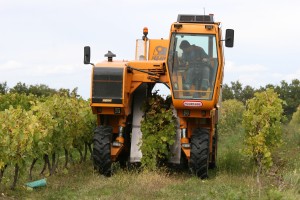 On the chosen day, usually at the end of September and depending on acidity and sugar levels, the whole region goes into action and mechanical harvesters work down the lines of grapes, plucking the clusters from the vines. The grapes are loaded into trucks and taken straight away to the presses. It is essential that they are crushed as quickly as possible to prevent sulphur dioxide forming on the skins. Modern presses are long rotating cylinders with slatted sides. Two stainless steel plates move in from the ends as the drums rotate releasing the juice until the pulp of the grape comes out. This is called the lees and is often used in the wine to produce a fruitier flavour.
On the chosen day, usually at the end of September and depending on acidity and sugar levels, the whole region goes into action and mechanical harvesters work down the lines of grapes, plucking the clusters from the vines. The grapes are loaded into trucks and taken straight away to the presses. It is essential that they are crushed as quickly as possible to prevent sulphur dioxide forming on the skins. Modern presses are long rotating cylinders with slatted sides. Two stainless steel plates move in from the ends as the drums rotate releasing the juice until the pulp of the grape comes out. This is called the lees and is often used in the wine to produce a fruitier flavour.
Generally the juice will take about 6-8 weeks before natural fermentation turns it into a wine with an alcohol content of around 8-9%. The wine is a cloudy liquid with a relatively acidic quality, ideal for distilling. It is usually stored in big concrete tanks before being checked for the optimum quality and pumped into the stills boiler for the heating and reduction process.
Read more about The Wines.
Distillation
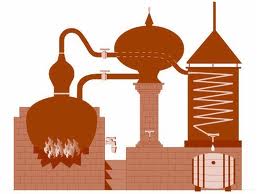 Distillation takes place in an Alembic Charentais still, of not more than 25 hectolitres and with a double distillation. The first provides a cloudy low alcohol liquid called broulis which is around 26% a.b.v. In some cases the general sediment from the wine, including the skins, pips etc, is added to provide a fruitier end product. This is of course filtered out before the second distillation which is usually at or around 70% a.b.v. The actual requirement is defined by the BNIC as being between 67 – 72% and generally the higher up the range, the more refined the finished product becomes. According to French law, cognac distillation must be completed by 31st March each year.
Distillation takes place in an Alembic Charentais still, of not more than 25 hectolitres and with a double distillation. The first provides a cloudy low alcohol liquid called broulis which is around 26% a.b.v. In some cases the general sediment from the wine, including the skins, pips etc, is added to provide a fruitier end product. This is of course filtered out before the second distillation which is usually at or around 70% a.b.v. The actual requirement is defined by the BNIC as being between 67 – 72% and generally the higher up the range, the more refined the finished product becomes. According to French law, cognac distillation must be completed by 31st March each year.
The Alembic still is traditionally heated with a wood or coal fire but today the use of gas and electricity is allowed enabling more control over the quality. Oil is never permitted for fear of tainting the eau de vie with the smell. The warmed wine is poured into the boiler on top of the heat source. Subjected to heat, the alcohol turns to steam which is caught and passed through a cooling coil turning it back into a liquid before running into a barrel. At every distillation the strength increases but it is not allowed to go too high for fear of burning the spirit. At the end of the distillation there is always a small amount of burnt wine left over which is thrown away. By the same token, at the beginning of the distillation process some of the spirit does not reach the right level so it is put back into the still.
Read more about The Still , The Wine Reduction and Distilling on the Lees.
Blending and Ageing
Once the distilled spirit (known as eau de vie) is made, it becomes a valuable commodity (a single batch of 25 hectolitres will usually take around 24 hours to produce). It is also subject to more duty. In the United Kingdom, duty is high, charged at around £28 per litre of pure alcohol. This adds nearly £8 to each bottle at 40% a.b.v. so it is essential that the distilled spirit is cared for and stored in ideal conditions.
Initially, the eau de vie is stored in new oak barrels that have not had any cognac in them before, for a period of about 6 months to a year providing some colour and modest flavour. At this stage it is the blender’s job to decide what combination, if any, of other eaux de vie is required to develop the brandy’s flavour. Because there is no one producer who can supply large enough quantities of eau de vie for the bigger brands, they buy their spirits from many producers and blend as many as 250 different ones. Inevitably, when large quantities are required, commercial pressures dictate that supply comes before quality. It is therefore usually the case that average barrel ages decline. Blending occurs in large vats, which hold up to 25,000 litres of brandy, before the cognac is transferred into old barrels to start its long ageing process. Vintage cognacs are of course not blended; they are kept in sealed barrels which are only opened once a year to check their quality and strength.
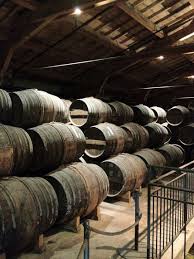 Cognacs must be aged in the barrel for a minimum of two years. In moist cellars the cognac will age more slowly, since the moisture will prevent the alcohol from evaporating, whereas in dry cellars, away from the river, the alcohol will come away quicker. It therefore follows that cognacs from the Grande Champagne, which borders the Charente River, will be of a higher quality than cognacs from lesser crus. As a broad average we can allow a loss of a degree in alcohol every year which means that it will take around 30 years to age naturally and some may take considerably longer. Not unnaturally, large brand leaders are not prepared to wait this long and choose to add water and additives such as caramel and sugar syrup to control colour and the fieriness of the spirit. Read more about cellars, here.
Cognacs must be aged in the barrel for a minimum of two years. In moist cellars the cognac will age more slowly, since the moisture will prevent the alcohol from evaporating, whereas in dry cellars, away from the river, the alcohol will come away quicker. It therefore follows that cognacs from the Grande Champagne, which borders the Charente River, will be of a higher quality than cognacs from lesser crus. As a broad average we can allow a loss of a degree in alcohol every year which means that it will take around 30 years to age naturally and some may take considerably longer. Not unnaturally, large brand leaders are not prepared to wait this long and choose to add water and additives such as caramel and sugar syrup to control colour and the fieriness of the spirit. Read more about cellars, here.
Some of the older houses will keep a special cellar known as the ‘Paradis’ where the very old and valuable cognacs are stored. Many of these may have been stored for more than 50 years and there are still some cognacs that may date back as far as 1800, or even earlier. Some very old cognacs are taken out of the barrels, to prevent further ageing, after they have reached their optimum condition. Some are without doubt of exceptional quality and will be of a value that is well beyond even 50 year old cognacs.
Read more about Barrels, Dilution, Balancing, Blending, Natural Colour and Changing Colour.
Only by establishing the true age of the cognac are we able to determine the quality of it. The longer the cognac has been in the barrel, the more likely it is that the flavour will be enhanced through contact with the oak. In old cognacs a ‘rancio’ can develop. The generic terms VS, VSOP and XO used with the more modern cognacs do nothing to describe how long the cognacs have been in the barrel. Even cognac described using the best term, XO, is only required to be 10 years old and fails demonstrably to provide any assurance as to the quality of the cognac.
Read more about the Rancio, Age of Cognac and Label Definitions.
Hermitage Cognacs
The Hermitage Cognacs range is different from and superior to any other cognac range available today.
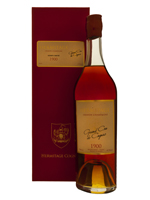
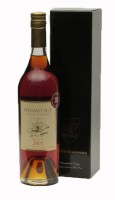 Hermitage Vintage Cognacs all have age statements and are regarded by many professionals in the drinks industry as the finest cognacs that they have ever tasted. They are sublime examples of the distillers’ skills and experience because they are single estate and not blended with hundreds of other cognacs that have already lost their identity. Hermitage Cognacs are all different and provide our customers with individuality and choice. A choice from the ‘premier cru’ where all the finest cognacs originate and a choice of cognacs that may have been started over a hundred years ago, aged in barrels and transformed into the most sublime nectar you have ever tasted.
Hermitage Vintage Cognacs all have age statements and are regarded by many professionals in the drinks industry as the finest cognacs that they have ever tasted. They are sublime examples of the distillers’ skills and experience because they are single estate and not blended with hundreds of other cognacs that have already lost their identity. Hermitage Cognacs are all different and provide our customers with individuality and choice. A choice from the ‘premier cru’ where all the finest cognacs originate and a choice of cognacs that may have been started over a hundred years ago, aged in barrels and transformed into the most sublime nectar you have ever tasted.
Our range starts with a 1900 and currently ends with a 2005 from the ‘premier cru’, Grande Champagne. There are many in-between including our Provenance range of cognacs, specifically aged and designed for some of our discerning customers outside of the UK. There are some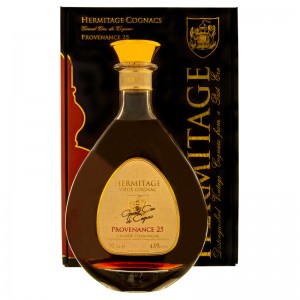 exceptions as well, such as the Hermitage 1914 from the Borderies, a cru famous for rich nutty cognacs and rated by a famous cognac writer as ‘the finest Borderies cognac that he has ever tasted’. We are not big; we simply want to make our customers happy buying cognacs that are made by people who understand cognacs and who seek the taste and quality that you could buy a hundred years ago.
exceptions as well, such as the Hermitage 1914 from the Borderies, a cru famous for rich nutty cognacs and rated by a famous cognac writer as ‘the finest Borderies cognac that he has ever tasted’. We are not big; we simply want to make our customers happy buying cognacs that are made by people who understand cognacs and who seek the taste and quality that you could buy a hundred years ago.
Hermitage Cognacs are not young, sugary offerings available in the high street shops. They are perfection in a bottle, a bottle called Hermitage.
Read more about Tasting Cognac , Cognac Tastes and Brandy Bottles.

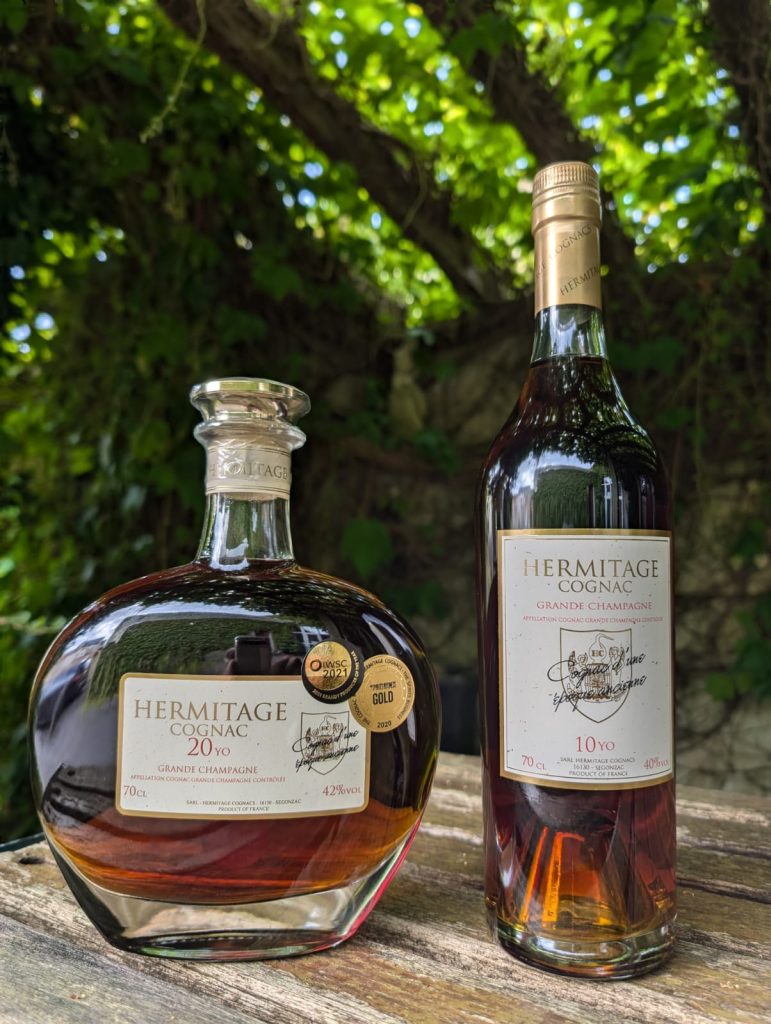



 On the chosen day, usually at the end of September and depending on acidity and sugar levels, the whole region goes into action and mechanical harvesters work down the lines of grapes, plucking the clusters from the vines. The grapes are loaded into trucks and taken straight away to the presses. It is essential that they are crushed as quickly as possible to prevent sulphur dioxide forming on the skins. Modern presses are long rotating cylinders with slatted sides. Two stainless steel plates move in from the ends as the drums rotate releasing the juice until the pulp of the grape comes out. This is called the lees and is often used in the wine to produce a fruitier flavour.
On the chosen day, usually at the end of September and depending on acidity and sugar levels, the whole region goes into action and mechanical harvesters work down the lines of grapes, plucking the clusters from the vines. The grapes are loaded into trucks and taken straight away to the presses. It is essential that they are crushed as quickly as possible to prevent sulphur dioxide forming on the skins. Modern presses are long rotating cylinders with slatted sides. Two stainless steel plates move in from the ends as the drums rotate releasing the juice until the pulp of the grape comes out. This is called the lees and is often used in the wine to produce a fruitier flavour.
 Cognacs must be aged in the barrel for a minimum of two years. In moist cellars the cognac will age more slowly, since the moisture will prevent the alcohol from evaporating, whereas in dry cellars, away from the river, the alcohol will come away quicker. It therefore follows that cognacs from the Grande Champagne, which borders the Charente River, will be of a higher quality than cognacs from lesser crus. As a broad average we can allow a loss of a degree in alcohol every year which means that it will take around 30 years to age naturally and some may take considerably longer. Not unnaturally, large brand leaders are not prepared to wait this long and choose to add water and additives such as caramel and sugar syrup to control colour and the fieriness of the spirit. Read more about
Cognacs must be aged in the barrel for a minimum of two years. In moist cellars the cognac will age more slowly, since the moisture will prevent the alcohol from evaporating, whereas in dry cellars, away from the river, the alcohol will come away quicker. It therefore follows that cognacs from the Grande Champagne, which borders the Charente River, will be of a higher quality than cognacs from lesser crus. As a broad average we can allow a loss of a degree in alcohol every year which means that it will take around 30 years to age naturally and some may take considerably longer. Not unnaturally, large brand leaders are not prepared to wait this long and choose to add water and additives such as caramel and sugar syrup to control colour and the fieriness of the spirit. Read more about

